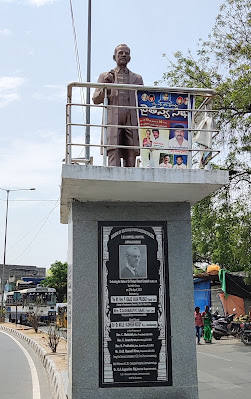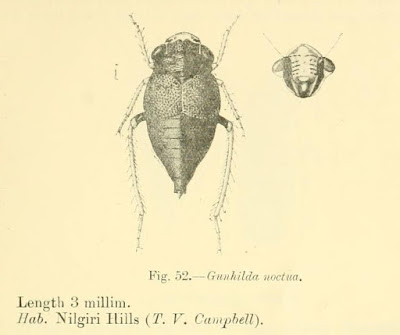Bangalore has historically, being an administrative centre with a mild climate, had a fair share of colonial natural history collectors and naturalists. We know a fair bit about the botanists who walked this region and a bit about hunters of larger game but rather little about those who studied insects. A few years ago I became aware of the Campbell brothers from Ireland (but of Scottish origin). It took some time to put together the Wikipedia entries on them which is where more straightforward biographical details may be found.
After a trip to the Nandi Hills [to examine a large number of heritage Eucalyptus trees (nearly 200 years old) that the Horticulture Department had decided to cut down to the stump, supposedly because falling branches were seen by the Archaeological Survey of India as a threat to heritage buildings nearby], some of us decided to visit Chikballapur to examine the place of work of Dr
Thomas Vincent Campbell (1863-16 December 1930) - "T.V." as he was known to his friends was a missionary doctor with the London Missionary Society and had worked briefly at Jammalamadugu where his older brother
William Howard Campbell (20 September 1859 - 18 February 1910) had worked as a missionary. Another brother back in Derry, David Callender Campbell (1860-1926) was also a keen observer of moths and a botanist. In their younger days in Derry, they and their siblings had put together a "family" museum of natural history that was said to be among the best in the region! William was the oldest of nine siblings and appears to have been the sturdiest considering that he was a champion rugby player at Edinburgh University. He moved to Cuddapah in 1884 and he may well have been the first person to see Jerdon's courser in life - Jerdon, Hume, and others appear to have dealt only with specimens obtained from local hunters. William collected moths and many of them appear to have gone to Lord Rothschild and nearly 60 taxa were described on their basis by Hampson. In 1909, he was to become director United Theological College Bangalore but ill health (sprue) forced him to return to Europe and he died in 1910 in Italy. His Cuddapah-born son Sir David Callender Campbell (1891 – 1963) became a prominent Northern Ireland politician. William's life is covered in some detail by Alan Knox while examining the only known egg of Jerdon's courser. A biography (a bit hagiographic though) of William in Telugu also exists.
T.V.'s life on the other hand was hard to find information on, we knew of his insect specimens. He was in contact with E.A. Butler who specialized in the life histories of insects and T.V. seems to have taken off after him and not only colllected bugs (ie Hemiptera) but made notes on them which were used by Distant in the Fauna of British India. Several insects that T.V. collected have never been seen again. T.V. moved to Chikaballapur and worked at the Ralph Wardlaw Thompson Memorial Hospital which is now just known as the CSI Hospital and largely in disrepair. The hospital in its heyday was among the few in the region and treated a large number of patients. After suffering from tuberculosis, he also established a TB sanatorium at Madanapalli. Campbell treated nearly a thousand cases of cataract and was awarded a Kaisar-i-Hind medal for work in 1908. Campbell appears to have made a very large collection of insects from Cuddapah, Chikballapur, and from the Ooty area (where he would have spent summers). Many of these are now in the Natural History Museum in London and a good number are type specimens (ie, the specimens on the basis of which new species were described). Professor C.A. Viraktamath, entomologist and specialist on the leafhoppers, has for many years searched for a supposedly wingless Gunhilda noctua which was collected from the Nilgiris. Based on T.V.'s connections, I believe the place to look for them would be somewhere in the vicinity of the church in Ketti. Considering the massive alteration in habitats, there is a slight chance that the species has gone extinct but it is doubtful that it was so narrow in its distribution.
 |
W.H. Campbell
|
 |
Dr T.V. Campbell
|
 |
T.V.'s former home in Chikaballapur
|
 |
Dr TV attending to patients in Chikaballapur, c. 1912
|
 |
A lane inside the hospital premises named after T.V.
|
 |
Foundation stone of the hospital
|
 |
The Wardlaw Thompson Hospital c. 1914
|
The Wikipedia entries can be found at
T.V. Campbell and
W.H. Campbell. Many people helped in the development of these articles. Roy Vickery kindly obtained a hard to find obituary of T.V., Alan Knox sent me some additional sources on W.H.C. and Susan Daniel, librarian at the United Theological College was extremely helpful. Arun Nandvar drove and S. Subramanya joined our little adventure in Chikaballapur. Dr Eric Lott made enquiries with the SOAS and LMS archives but found little. My entomologist friends and mentors, Prashanth Mohanraj and Yeshwanth H.M. shared their enthusiasm in discovering more about T.V.
POSTSCRIPT - April 2022: S. Subramanya and I visited Jammalamadugu (and nearby places including Buchupalli where WHC had found a large pelicanry). It seems that the hospital that TVC began continues to prosper. It seems to have gained the favour of the political class thanks to the association of the former Chief Minister Dr Y S R Reddy who was not only born in the Campbell Hospital but worked there too. Apparently very little is known of the work of W.H. Campbell who seems to have largely been active as a missionary. The village of Buchupalli where he had described a large pelicanry seems to have no signs of any large water birds and absolutely no memory among its current day residents (who might be three or four generations down from those that lived in the 1890s).
 |
The CSI Campbell Hospital
|
 |
The entrance
|
 |
Inscription below the statue with a gratuitous knighthood!
|
 |
Dr TV holds a disarticulated stethoscope!
|















No comments:
Post a Comment